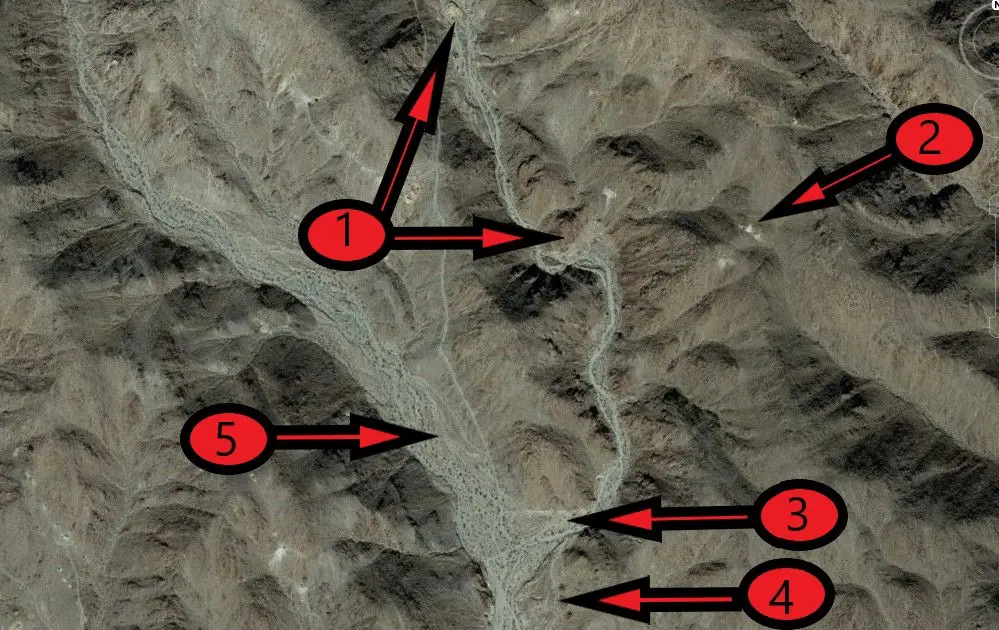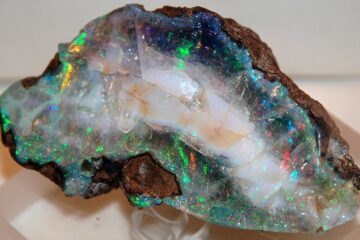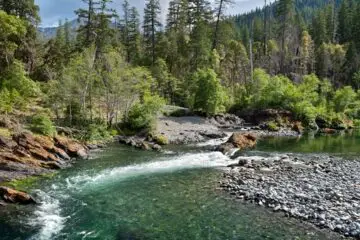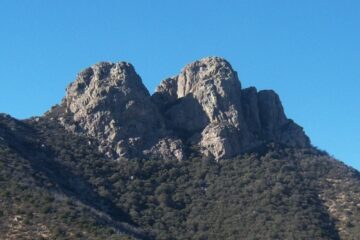Types of placer gold deposits found in desert dry washes
Small washes and tributary gold deposits
Prospecting smaller dry washes and tributaries can be some of the most productive areas for gold. Especially in areas with old hard rock prospects in the hills surrounding the washes.
Search these washes for places where bedrock is exposed or layers of false bedrock or caliche are only covered with thin gravel overburden. The idea is to take samples directly on bedrock.
Sometimes the bedrock will be loose and fractured. Every attempt should be made to remove such rock until it becomes solid. All the gravel should be carefully collected. Screwdrivers, ice picks, and chisels should be used to loosen any gravel that may be packed into cracks and crevices in the bedrock.
A stiff bristle brush or even a cordless shop-vac should be used to clean up the very last of the gravel as this is often where most of the gold will be. You can dry-pan these gravels or label samples with GPS waypoints to be panned later at camp or home.
Small washes with shallow gravels on bedrock are also great areas to use a gold detector. Careful sampling and detecting can help you find a gold patch that can be worked profitably with a drywasher.
Elevated gravel bench gold deposits
As you work your way up into the smaller washes scan the slopes above the wash for areas where sections of gravel have been left behind as the wash has been eroded deeper.
Be on the lookout for waterworn gravel benches, sometimes far above the current wash bottom. These can hold valuable gold deposits. Sometimes these benches will have sloping or nearly vertical sides that will clearly show different layers.
Take samples where these layers meet and of course wherever you find gravel resting on bedrock or false bedrock. Use care when sampling benches and do not put yourself downhill from a possible collapse.
These areas are also good places to scan with a gold detector. Gravels that show an orange tint due to iron oxides should always be investigated closely.
Flood gold and flood layers
Because all desert dry washes only have flowing water in flash flood conditions they lack the constant sorting and concentrating of gold and gravels of year-round or seasonal flowing watercourses.
Flood layers and flood gold can however re-accumulate in areas that have been worked in the past. Most of the old desert mining districts were worked by many men over many years.
The last of the real mining efforts in the desert placer areas were carried out with drywashers during the depression era of the 1930s. That means 80 or 90 years of flooding and erosion have taken place since.
In some areas, especially the smaller washes, the gold patches, and pockets have been at least partially replenished.
Pediment gold deposits
Pediments are broad surfaces or sloping plains of low relief that are often found in arid desert regions along the base of mountain slopes.
More recent washes may cut through pediments as they drain out of the mountain canyons.
Pediments may contain a layer or several layers of gravel that have paying amounts of gold. Pediments may be very deep, so when prospecting these types of deposits, try to find areas where the recent washes have exposed different layers so you can sample them easily.
Pediments can contain gravel layers that have been cemented by calcium carbonate and other fluids and chemical reactions. This type of cemented gravel is called caliche.
Pediments should be scanned with a gold detector as coarse gold may be found near the surface in some areas. Deep pediments are sometimes underlain by older dry washes called paleo-channels. These channels rest on bedrock and were sometimes worked by the old-timers using a method called drift mining.
Drift miners sunk shafts and then tunneled through the gravel along the bedrock. Drift mines following old paleo-channels were sometimes very rich. That being said, I do not recommend exploring old drift mines as they can be extremely dangerous.
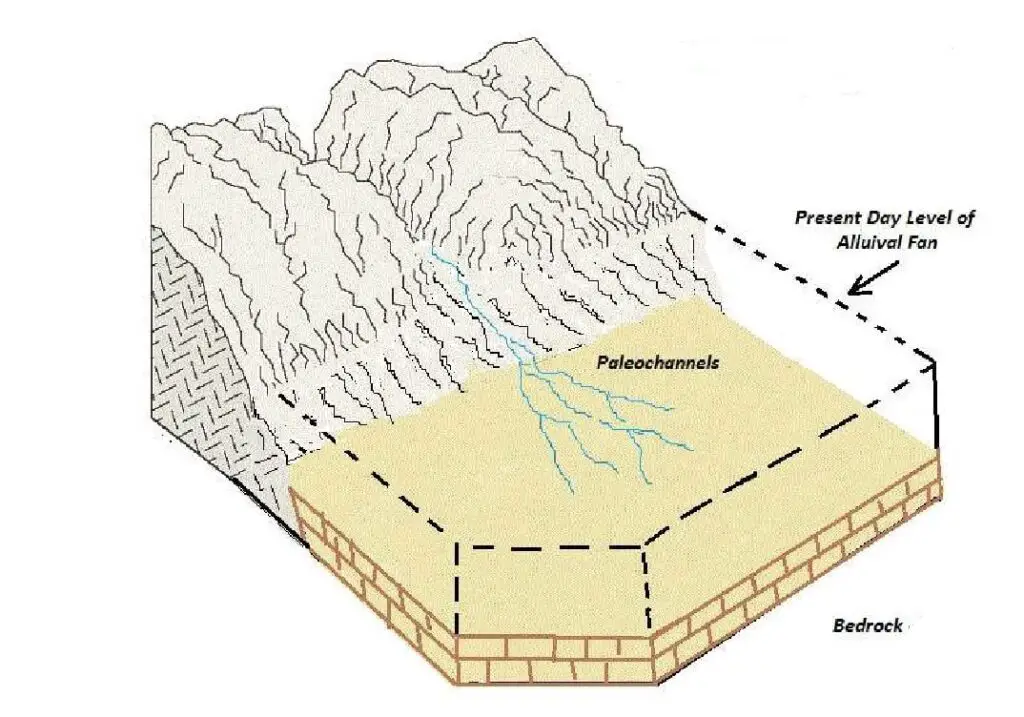
Large and main washes
The large main desert washes also contain gold. The problem with prospecting them is the fact that there are usually many, many feet of gravel on top of bedrock.
Also, water flows in flash flood conditions, meaning gold really has no way to concentrate and will be widely scattered throughout the wash.
If you can find areas where the slope of a wash changes from steep and narrow to flat and wide. In other words the mouth of a canyon, such spots can hold gold that has dropped out when the water velocity lessened.
There have been occasional large nuggets found by gold detectors in main washes that drain some mining districts. Sometimes several miles away. This is hit and miss at best, but hey, you never know.
If you are camped next to a large main wash you might want to scan it with your gold detector. Areas in and around drainage culverts should be checked also.
Tertiary gold deposits
Some of the richest gold-bearing gravels are from ancient tertiary rivers. These rivers flowed millions of years ago, and as such, they have mostly been eroded away.
Remember that tertiary rivers bear no relation to the current topography or the current direction of the desert washes. When prospecting desert washes keep your eyes open for patches of waterworn gravel and rock in areas of angular detritus.
These small sections of gravel may be found high up a mountain slope, in a saddle, or even on a ridgetop. In some areas, tertiary gravels can have a greyish blue color, which the old-timers called the blue lead. Some tertiary gravels have been said to contain several ounces per yard or more.
The screenshot above shows an area in an old gold mining district in the Mojave desert of southern California. I’ve highlighted some areas where I and others have found some good gold over the years.
- The arrows point to two hard rock or lode gold mines that produced a lot of gold during the late 1800s and early 1900s. Both of these mines were over 1000 feet deep. The dry wash just adjacent to them drains from the top towards the bottom of the image.
- Arrow points to a small hard rock prospect on the hillside. There are several more scattered around the slopes. Both 1 and 2 are indicators that gold may be found in the adjacent washes.
- I have used a gold detector in the wash that drains from 1 towards 3. Bedrock is quite deep in this area, and I had no luck until I worked the area around arrow 3. Notice that area 3 is located at the mouth of the canyon. This is where the wash flattens and widens right above it’s intersection with the large wash to the left. This is where the flood water velocity lessens and gold can then drop out and settle. I have detected several nice nuggets in this spot. I also know someone who detected a 2.5 ounce nugget from here.
- Arrow 4 points to an elevated pediment deposit that contains a gold-bearing gravel layer down about 18 to 24 inches. I have worked this layer with a drywasher several times with good results. Anywhere from 1 to 4 grams of coarse gold per yard.
- Arrow 5 points to the main wash that travels several miles through the district. There is no doubt a lot of gold in it. The depth to bedrock is so far and the floodwaters so powerful that gold is scattered everywhere. I have detected and drywashed this wash with no luck whatsoever
Keep these ideas in mind when out prospecting. All gold districts are different, and this area is known for its coarse gold. If you are in an area known for fine gold, you will probably do better prospecting the smaller washes with bedrock that is not too deep. But these basic clues will definitely help you in finding gold in desert washes.
A couple of related posts that may be of interest:
